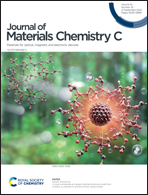Large-area SHG-CD probe intrinsic chirality in polycrystalline films†
Abstract
We used second harmonic generation (SHG) spectroscopy to study the chiroptical properties of R-, S- and racemic (RAC-) 1,1′-bi-2-naphthol (BINOL) films with various thicknesses, incidence angles and degrees of crystallization in the film. The SHG intensity measured at 337 nm increases for thicker films and upon crystallization, while the extracted SHG-circular dichroism (SHG-CD) shows two different regimes depending on the size of the investigated sample area. The data measured at small beam areas, compared to the supramolecular domain size, show strong variation of SHG-CD values depending on the local crystalline structure. In contrast, the anisotropy values measured for beam areas larger than the domain size are almost independent of local sample morphology, film thickness and incidence angle. The SHG-CD values change their sign upon sample flipping or going from R- to S-BINOL. Most interestingly, the observed SHG-CD almost coincides with the value reported for molecular monolayers. Our study reveals that SHG-CD measured with large beam areas can nullify the in-plane anisotropy by averaging over many domains, and thus directly probes intrinsic chirality of the sample. Molecule- and enantiospecific SHG-CD values for BINOL were obtained: ±1.06 for R- and S-BINOL, and 0.01 for racemic BINOL.



 Please wait while we load your content...
Please wait while we load your content...